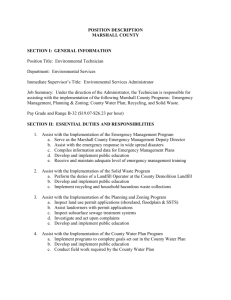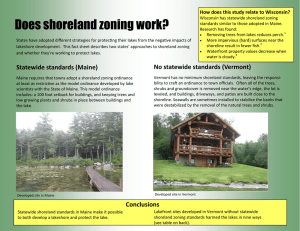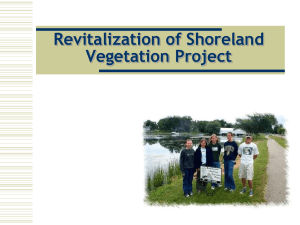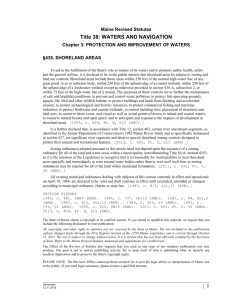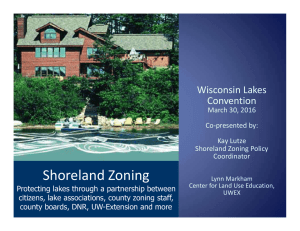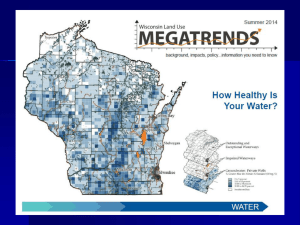A Guide for Buying and Managing Shoreland - GEO
advertisement
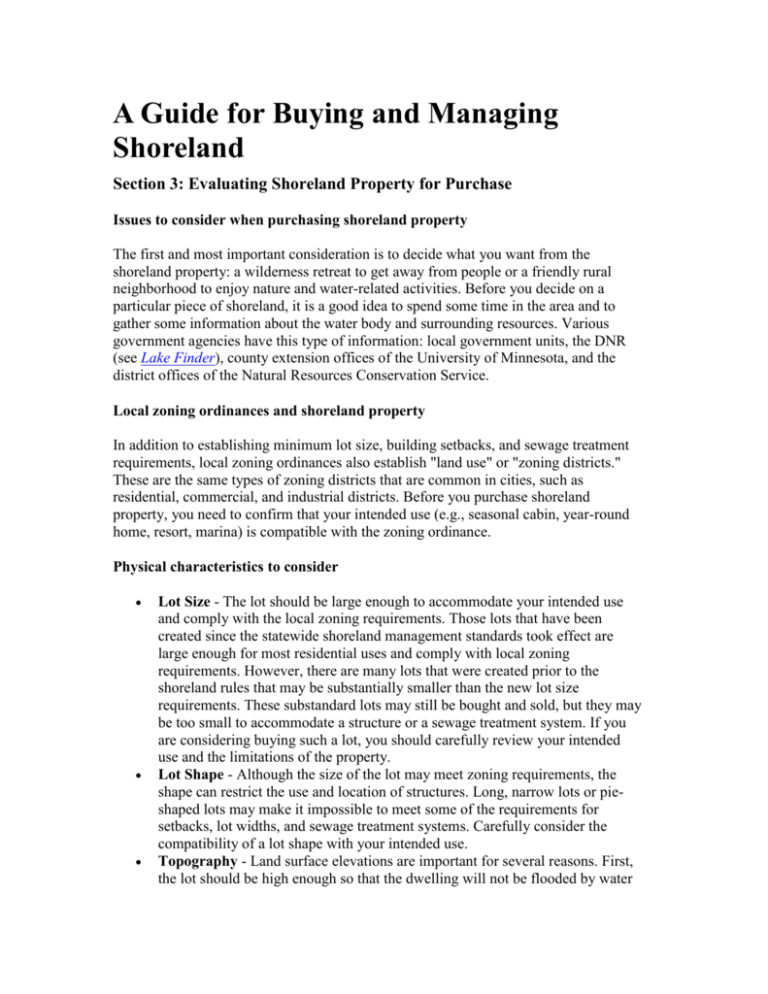
A Guide for Buying and Managing Shoreland Section 3: Evaluating Shoreland Property for Purchase Issues to consider when purchasing shoreland property The first and most important consideration is to decide what you want from the shoreland property: a wilderness retreat to get away from people or a friendly rural neighborhood to enjoy nature and water-related activities. Before you decide on a particular piece of shoreland, it is a good idea to spend some time in the area and to gather some information about the water body and surrounding resources. Various government agencies have this type of information: local government units, the DNR (see Lake Finder), county extension offices of the University of Minnesota, and the district offices of the Natural Resources Conservation Service. Local zoning ordinances and shoreland property In addition to establishing minimum lot size, building setbacks, and sewage treatment requirements, local zoning ordinances also establish "land use" or "zoning districts." These are the same types of zoning districts that are common in cities, such as residential, commercial, and industrial districts. Before you purchase shoreland property, you need to confirm that your intended use (e.g., seasonal cabin, year-round home, resort, marina) is compatible with the zoning ordinance. Physical characteristics to consider Lot Size - The lot should be large enough to accommodate your intended use and comply with the local zoning requirements. Those lots that have been created since the statewide shoreland management standards took effect are large enough for most residential uses and comply with local zoning requirements. However, there are many lots that were created prior to the shoreland rules that may be substantially smaller than the new lot size requirements. These substandard lots may still be bought and sold, but they may be too small to accommodate a structure or a sewage treatment system. If you are considering buying such a lot, you should carefully review your intended use and the limitations of the property. Lot Shape - Although the size of the lot may meet zoning requirements, the shape can restrict the use and location of structures. Long, narrow lots or pieshaped lots may make it impossible to meet some of the requirements for setbacks, lot widths, and sewage treatment systems. Carefully consider the compatibility of a lot shape with your intended use. Topography - Land surface elevations are important for several reasons. First, the lot should be high enough so that the dwelling will not be flooded by water level fluctuations. The site should be able to accommodate the lowest portion of the building, including the basement, at least 3 feet above the highest known water level. In nonsewered areas, the site must also accommodate an on-site sewage treatment system if the structure includes running water. The bottom of the sewage treatment system must be at least 3 feet above the highest known water level or bedrock. It is necessary to have a qualified professional determine if a site can accommodate a standard sewage system. Poorly located or designed systems result in frustration and added expense to the landowner. Erosion on steep slopes can cause problems. Many communities have specific restrictions on placement of structures and sewage systems on steep slopes, and require permits for grading, filling, or vegetation removal. Soil Conditions - The soils should be suitable for your intended use. Both structures and sewage treatment systems have specific requirements. Wet soils, shallow bedrock or clay soils are generally unsuitable for soil absorption sewage treatment systems and can also make building construction difficult. A filled wetland may appear to be stable, but compaction of the mucky subsoil may cause structural failure. Even if a local permit can be obtained, it is best to avoid development in these areas. Vegetation - Vegetation is part of the aesthetic and ecological value of shoreland property. Large trees and wooded landscapes are attractive and help to screen structures from the lake. Local zoning ordinances regulate the amount of vegetation that can be removed. In most communities, you can remove enough vegetation to obtain a view of the lake, as long as structures and vehicles are screened. Stricter controls on vegetation removal apply within certain shoreland areas. These zones must be kept in permanent vegetation. If the property is farmed, mowed crops and pasture are allowed. Tilling is not allowed unless it is under an approved conservation plan. The natural vegetation gives you clues about the suitability of your intended use. If you want a sandy swimming beach, you should look for a lot that has one. Any alterations at or below the water's edge will require DNR approval. Fill added to wetlands is also regulated by the U.S. Army Corps of Engineers' Section 404 permit program. The cost and questionable outcome of trying to develop in these areas may not be worth the effort. Wild Scenic Recreational Lot Size 6 4 2 300 250 200 - Ordinary High Water Level (OHWL) 200 150 100 - Designated Tributary 100 100 100 - Bluffline 40 30 20 - OHWL 150 100 75 - Designated Tributary 75 75 75 Lot Width at Water Line and Building Line (feet) Structure Setback From: (feet) Sewage Treatment Setback From: (feet) RIVER SET BACKS _______________________________________________________________________ Lake Classification Natural Environment Lakes usually have less than 150 total acres, less than 60 acres per mile of shoreline, and less than three dwellings per mile of shoreline. They may have some winter kill of fish; may have shallow, swampy shoreline; and are less than 15 feet deep. Recreational Development Lakes usually have between 60 and 225 acres of water per mile of shoreline, between 3 and 25 dwellings per mile of shoreline, and are more than 15 feet deep. General Development Lakes usually have more than 225 acres of water per mile of shoreline and 25 dwellings per mile of shoreline, and are more than 15 feet deep. ________________________________________________________________________ _______________ The complete septic system is made up of three primary components: Plumbing: wastewater collection Septic tank: primary treatment Soil treatment system: final treatment Because systems are individually designed and have been installed over many years, there are many variations in the features and descriptions that follow.


